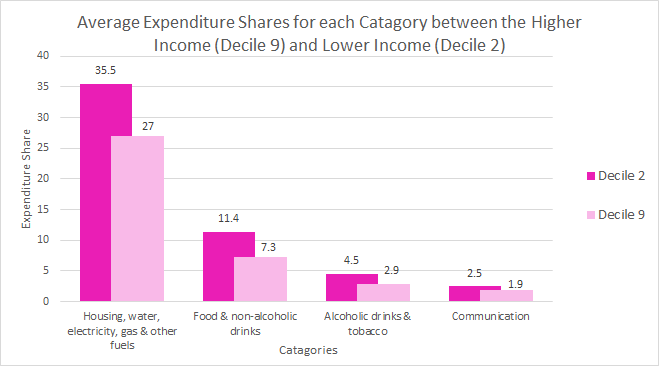If you said we would judge you against the average person how would you feel? Would that represent your situation?
This is how our inflation rate is measured and work between Nottingham Civic Exchange and the RSA will provide an alternative. The ONS has recently published analysis of spending and price patterns by 10 household income groups which shows that different households buy different things and these varying basket of goods change prices at different rates.
This project will spread awareness of the inner workings of this new data to help share ideas to create a way for people to understand how their circumstances impact on their inflation rate.
Why do we need change?
The Retail Price Index (RPI) was the original and longest-standing inflation measure in the UK but has been replaced by the CPIH (consumer price index including housing costs) in 2016.
Despite being the most comprehensive measure of inflation currently produced by the ONS, the CPIH doesn’t tell the full story. Alongside only highlighting, the average figure CPIH doesn’t measure credit card and household debt despite its rapid growth amongst UK households. Unsecured consumer debt amassed by British households is projected to reach 47% of income by 2021 and this isn’t currently being accounted for by your annual inflation rate.
The ONS recognises the challenges of using these measures and recently developed a more nuanced picture of inflation across the income distribution, which we will be exploring through this project. Creating a more detailed view inflation for all in society to challenge the use of a single average inflation rate is our goal.
Why we don’t experience the same inflation
The CPIH is produced by the ONS who compile a “shopping basket” consisting of around 700 annually-updated goods and services from across the country. This year you can wave goodbye to pork pies and leg waxes and say hello to pre-prepared mashed potato and women’s exercise leggings as peoples buying habits evolve.
The CPIH uses the same basket for every household in the UK, however the ONS has recently published analysis of spending and price patterns by 10 household income groups, which shows that not only do different households buy different things, but these prices change at different rates.
This under-examined factor is what we will be exploring in this project. The ONS analysis shows that lower income households (2nd income decile) spend proportionally more on “essentials” such as food and housing compared to higher income households (9th income decile), as illustrated by the graph below. Some of these differences can be ascribed to the ‘poverty premium', but we will be exploring how other issues create this difference through our project over the summer.

Addressing the increasing cost of economic insecurity
Addressing Economic Insecurity provides us an eye-opening account of just how underestimated the challenges of economic insecurity are in the UK. It is important to note that economic insecurity isn't solely the domain of lower-income households; the RSA found that 75% of us were concerned that the cost of living would continue to outpace wages. Median UK income is under-inflated by over £1000 over the last ten years.

The challenge we now face is to move towards a measures of inflation that better reflects the experiences of all UK households not just the average. The ONS have begun to address this with their new Household Cost Indices (HCI) currently under development. This has provided an invaluable insight into how different groups of households have experienced inflation but we don’t think it has received the attention it deserves.
Such an index should be used by policymakers looking at ways to improve living standards in a more refined way. Inflation experienced by lower incomes is higher than the national average; benefits could be uprated in line with the HCI figure so this group aren’t penalised by he changes to their inflation rate which could maintain their living.
How different is the result of CPIH and HCI?

Over the past decade, the average inflation annually using HCI and CPIH for higher income households was 2.21% and 2.16%, whilst for lower income households this was 2.58% and 2.45%. This shows inflation is increasing more for those in lower income households, and that HCI reflects a higher rate of inflation than the CPIH.

Since 2005 the price indices changes have increased most for the second decile as measured by the HCI. HCI shows how price changes have a much larger effect on the lower-income households as well as showing how the price changes have increased more for both households using HCI over CPIH.
We are advocating for a headline to breadline inflation measure to inform public policy as a progressive means to improve economic security and social equality and opportunity, and will be working to illustrate this through this project with the RSA.
Our aims are to research into the alternative 'breadline' measure formally known at the HCI as a counterpart to the 'headline' CPIH, in order to make a positive change. Watch this space to see our two follow up blogs, which will look into this issue further in the context of Brexit and other repercussions for ordinary working families through July.
This blog is the first in a series exploring the potential for a breadline inflation rate. It has been written by Katie Biggerstaff and Harry Cooke research students from Nottingham Trent University who are working with the RSA, Nottingham Civic Exchange and Nottingham Business School. Follow the project via #BreadlineInflation.
Katie Biggerstaff is a student at Nottingham Trent University; who is about to start an industrial placement after finishing her second year studying Economics with International Trade and Development. She is taking part in a student researching bursary scheme in association with the RSA and the Nottingham Civic Exchange; looking into alternative measures of price inflation for low income households. She will be producing three blog styled articles and work towards creating a data too along with another student. This is all in the hope of spreading awareness of the inner workings of household cost indices to a wider group; in order to address economic insecurities and improve inequality for those on the breadline by influencing public policy.
Harry Cooke is a student at Nottingham Trent University currently researching into the potential for a breadline inflation rate. His wider interests include structural inequalities, the minimum wage and alternatives to traditional economic metrics such as GDP.
Related articles
-
Our social insecurity system
Hannah Webster
How can we regenerate our social security system to remove insecurity and ensure everyone is receiving the support they need to survive?
-
Using economic strategies to improve health outcomes
Ian Burbidge
Ian Burbidge on the importance of an inclusive economy that provides equitable healthcare to the public.
-
A healthy economy?
Ian Burbidge Will Grimond
Covid shows us how our health and the economy are linked. Politics has been slow to catch up on the connection.





Be the first to write a comment
Comments
Please login to post a comment or reply
Don't have an account? Click here to register.